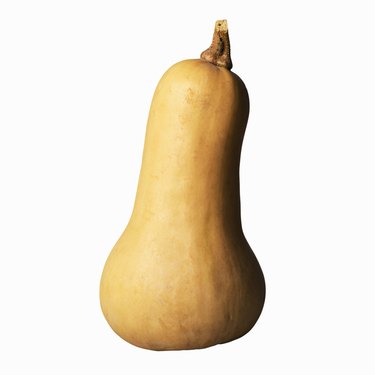Things You'll Need
Squash seedlings
Trellis
Plant ties

The square foot gardening method, developed by Mel Bartholomew, allows you to grow more plants in less space compared to conventional gardening practices. Butternut squash is considered a large plant when using this method, so it is assigned a full square foot per plant. Trellising the squash in the garden bed allows it to grow upright so it doesn't take up more than the allotted square foot of soil. A simple trellis consisting of wire netting stretched between two stakes is sufficient for supporting the squash.
Step 1
Plant one butternut squash seedling per square foot, utilizing the squares on the trellis side of the garden bed. Plant the seedlings at the same depth they were growing at in their seedling pots.
Video of the Day
Step 2
Water the plants one to two times weekly so the squash receives approximately 1 inch of moisture per week. Keeping the soil moist to a depth of 6 inches is sufficient.
Step 3
Guide the squash vines onto the trellis netting once they are long enough to reach. Butternut squash vines primarily climb the trellis on their own, but tying the heavier vines in place loosely with a cloth plant tie makes the plant more secure.
Step 4
Pinch the top of the vine off once it reaches the top of the trellis. Alternatively, guide the vine down the back side of the trellis, using plant ties to secure it in place.
Step 5
Cut 1-foot-long strips from old T-shirts or other somewhat stretchy material. Tie the ends of the fabric strips to the trellis directly below each developing butternut squash so they form a sling. Place the squash inside the sling to support the fruit's weight as it grows.
Step 6
Harvest the squash from the vine once it's mature. Butternut squash develops a hard rind and an even pale orange or light tan color when ripe.
Tip
Plant the butternut squash on the north side of the garden bed so it doesn't block sunlight to any lower-growing plants in the front of the garden.
Sow squash seeds directly in the garden bed after the last spring frost instead of planting transplants.
Video of the Day